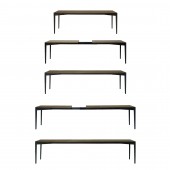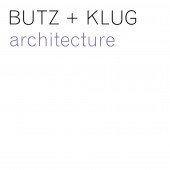The "Taut" Table Dining Table by BUTZ + KLUG Architecture |
Home > Winners > #26618 |
 |
|
||||
| DESIGN DETAILS | |||||
| DESIGN NAME: The "Taut" Table PRIMARY FUNCTION: Dining Table INSPIRATION: This table is inspired by the richness and poignancy of the rituals around dining and the frustration that the structure of the typical table often places in the way of these rituals. UNIQUE PROPERTIES / PROJECT DESCRIPTION: The table takes as its expressive point of departure the act of expanding the table, making it a taut, thin plane with a materially rich surface. OPERATION / FLOW / INTERACTION: The arrangement of people around a table is determined by the location of chairs, which, in turn, are governed by the location legs. Placing the legs at the extreme corners and coupling this with expandable leaves allows for the maximum variation of social patterns. Typically, this results in a structural compromise; here, however, it becomes a design opportunity. The expansion of the table is itself an event, with every leaf increasing the tables’ tautness. PROJECT DURATION AND LOCATION: This project began in June of 2009 in Boston, MA, and finished in January of 2011. FITS BEST INTO CATEGORY: Furniture Design |
PRODUCTION / REALIZATION TECHNOLOGY: The Table was built by local craftsmen using traditional woodworking tools. The tabletop material, a veneer made from recycled ebony furniture, is layered at the fileted edge, enhancing the tautness of the material as though it is stretched over the top; the legs are painted Maple. The leaves are attached to one another with a steel spline and are held tightly together by rare earth magnets allowing the Top to retain its structural integrity. SPECIFICATIONS / TECHNICAL PROPERTIES: Length: 3048 mm (expanded); Depth: 990.6 mm; Height: 844.55 mm TAGS: Dining Table, Custom Furniture Design RESEARCH ABSTRACT: - CHALLENGE: The legs and the apron of most tables are its structure. The top is merely a surface supported by the legs and plays no structural role. This results in either: 1) Table legs competing with human legs because they are far inboard of the edge of the table so the apron misses our knees, or 2) An apron that requires you to slide your chair completely out to stand up because it is located at the outer edge of the Table. We wanted to design a table that used the top as a structural element in order to eliminate the apron while placing the legs at the extreme corners to allow for the most spontaneous sitting arrangements. The challenge was compounded by making the table expandable and integrating the leaves structurally into the top. ADDED DATE: 2012-09-24 10:09:14 TEAM MEMBERS (5) : Pamela Butz, Jeffrey Klug, Deborah Buelow, Chris Rice and Mark Heron IMAGE CREDITS: BUTZ + KLUG Architecture, 2012. |
||||
| Visit the following page to learn more: http://www.bkarch.com/ | |||||
| AWARD DETAILS | |
 |
The "taut" Table Dining Table by Butz + Klug Architecture is Winner in Furniture Design Category, 2012 - 2013.· Read the interview with designer BUTZ + KLUG Architecture for design The "Taut" Table here.· Press Members: Login or Register to request an exclusive interview with BUTZ + KLUG Architecture. · Click here to register inorder to view the profile and other works by BUTZ + KLUG Architecture. |
| SOCIAL |
| + Add to Likes / Favorites | Send to My Email | Comment | Testimonials | View Press-Release | Press Kit |
Did you like Butz + Klug Architecture's Furniture Design?
You will most likely enjoy other award winning furniture design as well.
Click here to view more Award Winning Furniture Design.








